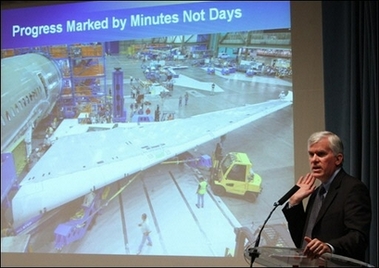Americas
Boeing unveils 'green' Dreamliner passenger jet
(AFP)
Updated: 2007-07-05 01:49
 |
Large Medium Small |
 Mike Bair, Vice President and General Manager of US Boeing Commercial Airplanes, talks during a press conference about the new Boeing 787 "Dreamliner" long-haul aircraft at the 47th Paris International air show, 19 June 2007, at Le Bourget Airport. The mid-sized plane, which seats up to 330 passengers and is capable of flying long-haul routes using up to 20 percent less fuel while pumping out fewer greenhouse gases, will be rolled out on Sunday, for 300 gathered media.[AFP]  |
The mid-sized plane, which seats up to 330 passengers and is capable of flying long-haul routes using up to 20 percent less fuel while pumping out fewer greenhouse gases, will be rolled out for 300 gathered media.
The 787 -- Boeing's first new model in 13 years -- will make its maiden test flight later this year before going into commercial service with Japan's All Nippon Airways (ANA) in 2008.
The new aircraft boasts several revolutionary design features, most notably the use of high-tech plastic composites instead of aluminium.
Up to 50 percent of the primary structure of the plane -- including the fuselage and wing -- will be made of composites such as carbon-fiber.
"By manufacturing a one-piece fuselage section, we are eliminating 1,500 aluminum sheets and 40,000 - 50,000 fasteners," Boeing said in a statement.
The composites used in the Dreamliner are also stronger and lighter than traditional materials, allowing the plane greater fuel efficiency.
"In addition to bringing big-jet ranges to mid-size airplanes, the 787 will provide airlines with unmatched fuel efficiency, resulting in exceptional environmental performance," Boeing has said. "The airplane will use 20 percent less fuel for comparable missions than today's similarly sized airplane."
Lower fuel-costs could in theory lead to cheaper long-haul travel, aviation industry analysts say.
Richard Aboulafia, chief analyst with the Teal Group Corporation, said the Dreamliner was poised to revolutionize air travel if its projected rates of fuel-efficiency proved accurate.
"If you look at it from an airline standpoint: you don't have a choice," Aboulafia told AFP. "If you don't have a 787-class aircraft and your competitor does, he can under-price you and out-profit you.
"We can't be sure of their performance objectives, but if it does what they say, it's revolutionary, both in terms of the plane's operating economics and durability," Aboulafia added.
Scott Hamilton of aviation industry analysts Leeham Co echoed Aboulafia's assessment. "This is the next evolutionary step in aviation," Hamilton told US media. "It's a game-changer for its manufacturing and assembly processes and will probably be mimicked by succeeding airplanes."
The Dreamliner's other innovations include greater levels of comfort for passengers, with higher humidity levels within the cabin expected to reduce passenger dehydration.
Boeing, which aims to build 2,000 Dreamliners over the next two decades, has so far received 634 orders from 45 companies for the plane, which has a catalogue price of between 146 to 200 million dollars.
The 787 will go into service after Airbus's mammoth A380 takes to the skies. The first units of the double-decker superjumbo -- capable of seating up to 800 passengers -- will be delivered to Singapore Airlines in October.
Analysts say the Dreamliner and the A380 reflect the different strategies of Boeing and Airbus as they seek to achieve the same objective -- cheaper air travel. In response to Boeing's Dreamliner, Airbus has announced plans for a further new model, the A350. But the new plane is not expected to be ready for commercial use until 2013.
| 分享按钮 |